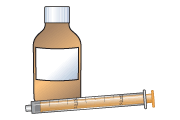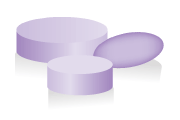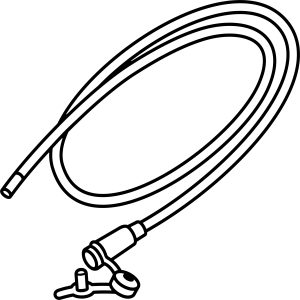Glycopyrronium to reduce saliva production
This leaflet is for parents and carers about how to use this medicine in children. Our information may differ from that provided by the manufacturers, because their information usually relates to adults. Read this leaflet carefully. Keep it somewhere safe so that you can read it again.
Name of medicine
Glycopyrronium
Brand names: Sialanar, Assico
- Tablets and liquid medicine are also made by several different manufacturers and are labelled as glycopyrronium bromide, glycopyrronium or glycopyrrolate – these are the same medicine.
- Brands of this medicine may differ so it is important that your child always has the same one. Keep a record of which brand your child has. If you are given a different one, check how much you should give your child.
Why is it important for my child to take Glycopyrronium?
Children with some conditions that affect the nerves or muscles in the face have difficulty swallowing the saliva produced in their mouth. This can lead to dribbling and drooling. Glycopyrronium bromide helps to reduce the amount of saliva that is produced.
What is Glycopyrronium available as?
- Liquid medicine: 1 mg per 5ml or 2 mg per 5 mL
(Sialanar contains 1.6 mg glyopyrronium per 5 mL)
- Tablets: 1 mg, 2 mg
When should I give Glycopyrronium
Glycopyrronium can be given once, twice or three times a day. Your doctor will tell you how often to give it.
- If given once each day, this can be in the morning or the evening.
- If given twice each day, give one dose in the morning and one in the evening. Ideally these times are 10–12 hours apart. For example, this could be between 7 and 8 am and between 7 and 8 pm.
- If given three times each day, these should be 6 hours apart, depending on what time your child wakes up and goes to bed. For example, this could be between 7 and 8 am, between 1 and 2 pm, and between 7 and 8 pm.
Give the medicine at about the same time(s) each day so that this becomes part of your child’s daily routine, which will help you to remember.
Glycopyrronium should be given at least 1 hour before food or 2 hours after food. If this is difficult, the gap between giving the medicine and food should be similar each time. High-fat food should be avoided.
How much should I give?
- Your doctor will work out the amount of medicine (the dose) that is right for your child. The dose will be shown on the medicine label.
- Your doctor will probably suggest that your child starts on a low dose. They may then increase the dose over a period of days or weeks, depending how your child responds to the medicine. If you are not sure how much to give, check with your doctor or pharmacist.
It is important that you follow your doctor’s instructions about how much to give.
Different brands may contain different amounts of Glycopyrronium. If you are given a different brand, read the label carefully so you know how much to give.
How should I give Glycopyrronium?

Liquid medicine
Shake the medicine well. Measure out the right amount using an oral syringe or medicine spoon. You can get these from your pharmacist. Do not use a kitchen teaspoon as it will not give the right amount. Make sure your child takes it all straight away.

Tablets
Tablets should be swallowed with a glass of water or juice. Your child should not chew the tablet.

Feeding tube
Glycopyrronium can be given via feeding tube. Information on giving medicines via a gastrostomy tube or nasogastric tube can be found here: www.medicinesforchildren.org.uk/advice-guides/giving-medicines
When should the medicine start working?
Glycopyrronium starts to work straight away. However, because the dose is usually increased gradually, it may take some weeks before you see the full effect.
What if my child is sick (vomits)?
- If your child is sick less than 30 minutes after having a dose of Glycopyrronium, give them the same dose again.
- If your child is sick more than 30 minutes after having a dose of Glycopyrronium, do not give them another dose. Wait until the next normal dose.
If your child is sick again, seek advice from your family doctor, nurse, pharmacist, or hospital. They will decide what to do based on your child’s condition and the specific medicine involved.
What if I forget to give it?
If you miss a dose, wait until the next normal dose. Do not give the missed dose.
Never give a double dose of Glycopyrronium.
What if I give too much?
If you think you may have given your child too much Glycopyrronium, contact your doctor or local NHS services (details at end of leaflet) or take your child to hospital. Have the medicine container or packaging with you, even if it is empty. This will be useful to the doctor.
It may be dangerous to give too much Glycopyrronium.
Are there any possible side effects?
We use medicines to make our children better, but sometimes they have other effects that we don’t want (side effects).
Side effects you must do something about
If your child is short of breath or is wheezing, or their face, lips or tongue start to swell, or they develop a rash, they may be allergic to Glycopyrronium. Take your child to hospital or phone for an ambulance straight away.
If your child is constipated (has difficulty doing a poo) or cannot pass urine (wee) when they need to, contact your doctor for advice. Do not give any more Glycopyrronium.
If your child has a high temperature (over 38C), a chest infection or if you notice any changes in behaviour, contact your doctor. Do not give any more Glycopyrronium.
Can other medicines be given at the same time as Glycopyrronium?
You can give your child medicines that contain paracetamol or ibuprofen, unless your doctor has told you not to.
Check with your doctor or pharmacist before giving any other medicines to your child. This includes herbal and complementary medicines.
Is there anything else I need to know about this medicine?
- Because glycopyrronium reduces the amount of saliva produced, your child’s teeth may be at risk of harm. Brush your child’s teeth as usual twice a day (morning and evening); there is no need to brush more often this. Make sure your child’s teeth are checked regularly by a dentist.
- • You may be given a “patient alert card”, which explains about the side-effects of glycopyrronium and what to do about them. The card also provides a table for your doctor to record how much medicine your child should have. Give this card to anyone who treats your child.
General advice about medicines
- Try to give medicines at about the same times each day, to help you remember.
- Only give this medicine to your child. Never give it to anyone else, even if their condition appears to be the same, as this could do harm.
- Make sure that you always have enough medicine. Order a new prescription at least 2 weeks before you will run out.
- Make sure that the medicines you have at home have not reached the ‘use by’ date on the packaging. Give old medicines to your pharmacist to dispose of.
Where should I keep this medicine?
- Keep the medicine in a cupboard, away from heat and direct sunlight. It does not need to be kept in the fridge.
- Make sure that children cannot see or reach the medicine.
- Keep the medicine in the container and packaging it came in.
Who to contact for more information?
Your doctor, pharmacist or nurse will be able to give you more information about Glycopyrronium and about other medicines used to reduce saliva production.
You can also get useful information from:
England: NHS 111
Tel 111
www.nhs.ukScotland: NHS 24
Tel 111
www.nhs24.scotNorthern Ireland: NI Direct
Wales: NHS 111 Wales
Tel 111
www.111.wales.nhs.ukCopyright disclaimer
Version [1]. © NPPG, RCPCH and WellChild, all rights reserved. Review by December 2026.
The primary source for the information in this leaflet is the British National Formulary for Children. For details on any other sources used for this leaflet, please contact us through our website, www.medicinesforchildren.org.uk.
We take great care to make sure that the information in this leaflet is correct and up-to-date. However, medicines can be used in different ways for different patients. It is important that you ask the advice of your doctor or pharmacist if you are not sure about something. This leaflet is about the use of these medicines in the UK, and may not apply to other countries. The Royal College of Paediatrics and Child Health (RCPCH), the Neonatal and Paediatric Pharmacists Group (NPPG), WellChild and the contributors and editors cannot be held responsible for the accuracy of information, omissions of information, or any actions that may be taken as a consequence of reading this leaflet.
